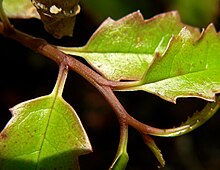
The basal angiosperms are the flowering plants which diverged from the lineage leading to most flowering plants. In particular, the most basal angiosperms were called the ANITA grade, which is made up of Amborella (a single species of shrub from New Caledonia), Nymphaeales (water lilies, together with some other aquatic plants) and Austrobaileyales (woody aromatic plants including star anise).
ANITA stands for Amborella, Nymphaeales, I lliciales, Trimeniaceae, and Austrobaileya. Some authors have shortened this to ANA-grade for the three orders, Amborellales, Nymphaeales, and Austrobaileyales, since the order Iliciales was reduced to the family Illiciaceae and placed, along with the family Trimeniaceae, within the Austrobaileyales.
The basal angiosperms are only a few hundred species, compared with hundreds of thousands of species of eudicots, monocots, and magnoliids. They diverged from the ancestral angiosperm lineage before the five groups comprising the mesangiosperms diverged from each other.
Phylogeny

Amborella, Nymphaeales and Austrobaileyales, in that order, are basal to all other angiosperms.
| Angiospermae |
| ||||||||||||||||||
Older terms

Paleodicots (sometimes spelled "palaeodicots") is an informal name used by botanists (Spichiger & Savolainen 1997, Leitch et al. 1998) to refer to angiosperms which are not monocots or eudicots.
The paleodicots correspond to Magnoliidae sensu Cronquist 1981 (minus Ranunculales and Papaverales) and to Magnoliidae sensu Takhtajan 1980 (Spichiger & Savolainen 1997). Some of the paleodicots share apparently plesiomorphic characters with monocots, e.g., scattered vascular bundles, trimerous flowers, and non-tricolpate pollen.
The "paleodicots" are not a monophyletic group and the term has not been widely adopted. The APG II system does not recognize a group called "paleodicots" but assigns these early-diverging dicots to several orders and unplaced families: Amborellaceae, Nymphaeaceae (including Cabombaceae), Austrobaileyales, Ceratophyllales (not included among the "paleodicots" by Leitch et al. 1998), Chloranthaceae, and the magnoliid clade (orders Canellales, Piperales, Laurales, and Magnoliales). Subsequent research has added Hydatellaceae to the paleodicots.
The term paleoherb is another older term for flowering plants which are neither eudicots nor monocots.
References
- Thien, L. B.; Bernhardt, P.; Devall, M. S.; Chen, Z.-d.; Luo, Y.-b.; Fan, J.-H.; Yuan, L.-C.; Williams, J. H. (2009), "Pollination biology of basal angiosperms (ANITA grade)", American Journal of Botany, 96 (1): 166–182, doi:10.3732/ajb.0800016, PMID 21628182
- Yin-Long Qiu; Jungho Lee; Fabiana Bernasconi-Quadroni; Douglas E. Soltis; Pamela S. Soltis; Michael Zanis; Elizabeth A. Zimmer; Zhiduan Chen; Vincent Savolainen; Mark W. Chase (1999). "The earliest angiosperms: Evidence from mitochondrial, plastid and nuclear genomes". Nature. 402 (6760): 404–407. Bibcode:1999Natur.402..404Q. doi:10.1038/46536. PMID 10586879. S2CID 4380796.
- APG (2016). "An update of the Angiosperm Phylogeny Group classification for the orders and families of flowering plants: APG IV". Botanical Journal of the Linnean Society. 181 (1): 1–20. doi:10.1111/boj.12385.
- Rudolphe Spichiger & Vincent Savolainen. 1997. Present state of Angiospermae phylogeny. Candollea 52: 435-455 (text Archived March 12, 2007, at the Wayback Machine)
- Leitch, I. J., M. W. Chase, and M. D. Bennett. 1998. Phylogenetic analysis of DNA C-values provides evidence for a small ancestral genome size in flowering plants. Annals of Botany 82 (Suppl. A): 85-94.
- "An update of the Angiosperm Phylogeny Group classification for the orders and families of flowering plants: APG III". Botanical Journal of the Linnean Society. 161 (2): 105–121. 2009. doi:10.1111/j.1095-8339.2009.00996.x. hdl:10654/18083. ISSN 0024-4074.
- Qiu, Yin-Long; Li, Libo; Wang, Bin; Xue, Jia-Yu; Hendry, Tory A.; Li, Rui-Qi; Brown, Joseph W.; Liu, Yang; Hudson, Geordan T.; Chen, Zhi-Duan (2010). "Angiosperm phylogeny inferred from sequences of four mitochondrial genes". Journal of Systematics and Evolution. 48 (6): 391–425. doi:10.1111/j.1759-6831.2010.00097.x. hdl:2027.42/79100. S2CID 85623329.
- Jaramillo, M. Alejandra; Manos, PS (2001), "Phylogeny and Patterns of Floral Diversity in the Genus Piper (Piperaceae)", American Journal of Botany, 88 (4), Botanical Society of America: 706–16, doi:10.2307/2657072, JSTOR 2657072, PMID 11302858
External links
| Orders of flowering plants (APG IV) | ||||||||||||||||||||||||||||||||||||||||||||||||||
|---|---|---|---|---|---|---|---|---|---|---|---|---|---|---|---|---|---|---|---|---|---|---|---|---|---|---|---|---|---|---|---|---|---|---|---|---|---|---|---|---|---|---|---|---|---|---|---|---|---|---|
| Angiosperms |
|  | ||||||||||||||||||||||||||||||||||||||||||||||||